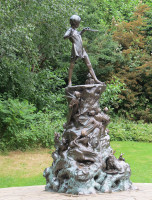
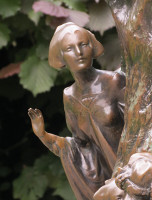
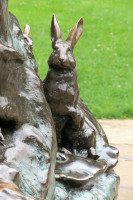
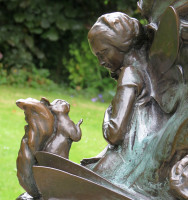
The Peter Pan Monument in Kensington Gardens was at one time one of the most popular sculptures in London, and over 100 years since it was erected, still attracts a small crowd of visitors during the summer months. It was shown at the Royal Academy in 1911, and the final bronze was emplaced in Kensington Gardens in 1912, which is the date inscribed by the artist’s signature. A replica was made for Liverpool’s Sefton Park in 1928, the last year in the life of the sculptor, George Frampton.
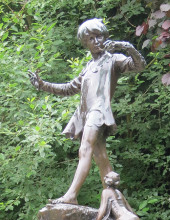
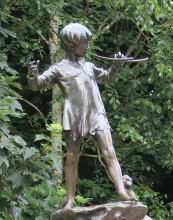 The statue of Peter Pan, by George Frampton.
The statue of Peter Pan, by George Frampton.
The figure of Peter Pan is about lifesize, thus boy sized, and he stands with one foot forward, his arms wide, one of them holding his pipes on which he is blowing. His apparent age about eight years old or so, and in keeping with this, his hair is cut simply to the same length around his head, and he wears a single garment, a light nightshirt, with a decorative collar with a drawstring that puts the figure firmly in the early 20th Century.
Two aspects of the tree-trunk, with fairies and animals.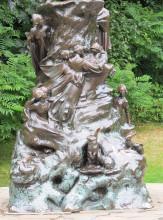
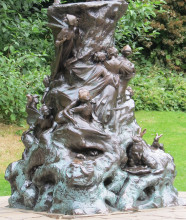
So much for the figure – the rest of the monument is the tall base, perhaps something over seven feet high, which is the novel and attractive part of the whole. It it is made as some forest treestump, and all over it are a variety of fairies and small animals, which draw the visitor, particularly the younger visitor, to walk up to and all the way around the monument.
The fairies are shown as winged girls, dressed in long robes, light and diaphanous to show the figure when pressed against it, or hanging in graceful folds when hanging loose; these robes are clasped by a button between the breasts, with some undershirt exposed below the neck, and depending on the figure, have loose sleeves or leave the arms bare. Below, their feet are generally hidden or covered, but one, standing on tiptoes, wears light slippers as if a ballerina.
The girls' faces are youthful, and their hair is cut short to expose the slender necks, for these are Edwardian fairies. Their hands are long and expressive, and the overall impression is of suppleness and grace, most charming.
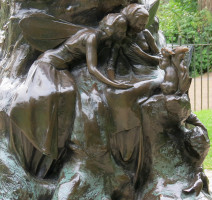
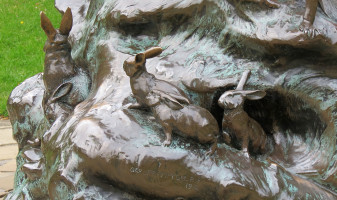
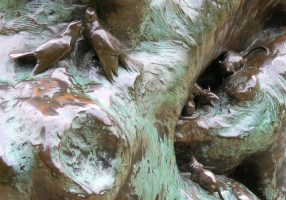
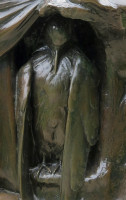 Small animals on the tree stump.
Small animals on the tree stump.
One squirrel stands up gazing at a pair of seated fairies, forming a particularly engaging group, but the other animals are mostly in hollows or emerging from holes in the treetrunk. A group of three small rabbits emerge from a hole, following a larger one in front with a companion. A long-winged bird lurks in a niche over which a fairy is climbing. A pair of small birds nibble at each other affectionately, near to a group of mice. The modelling is excellent, and the sculptor has caught the essence of mouse in these small works.
George Frampton, the sculptor, was a versatile artist whose work can be seen across the country. His empathetic portrait statues include Canon Major Lester in Liverpool (see this page), Quintin Hogg in Portland Place and the Marquis of Salisbury among others, his allegorical figures include a large number of figures for Lloyds Registry in Fenchurch Street, the well known Symbolist sculpture Mysteriarch and spandrel girls for Electra House in Moorgate and for the V&A, and a variety of memorials. It is these memorials, often with pairs of small allegorical females, along with the allegorical girls of his architectural sculpture, that are most similar to the Peter Pan figures, but really the Peter Pan is unique in his oeuvre.
This page was originally part of a 'sculpture of the month' series, for June 2014. Although the older pages in that series have been absorbed within the site, if you would wish to follow the original monthly series, then jump to the next month (July 2014) or the previous month (May 2014). To continue, go to the bottom of each page where a paragraph like this one allows you to continue to follow the monthly links.
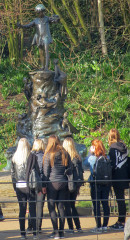 New visitors to the Peter Pan monument.
New visitors to the Peter Pan monument.
George Frampton // London sculpture
Visits to this page from 1 June 2014: 11,587